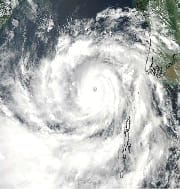Cyclone Burevi: Key Facts
The cyclone Burevi, named by Maldives, hit the Karaikal coast of Tamil Nadu 7 days after cyclone Nivar. This is the third cyclone formed within the last 10 days in the Bay of Bengal and Arabian Sea put together.
Why is Cyclone Burevi not as strong as Cyclone Nivar?
As the new cyclone Burevi comes just days after Cyclone Nivar, its impact is set to be more subdued. This is because when consecutive systems develop in the same region of the sea, the first system leads to a process called ‘upwelling’- i.e. cooler water from the deeper parts of the ocean moves towards the upper layer and produce less friendly conditions for cyclones.
Cyclone Burevi
Cyclone Burevi is the third cyclone to hit Tamil Nadu in two years after Cyclone Gaja in 2018 and Cyclone Nivar recently. It is the fifth cyclone that has taken shape in the North Indian ocean region in 2020. The other four cyclones were Cyclone Gati, Cyclone Nisarga, Cyclone Nivar and Cyclone Amphan.
Cyclone Gati made landfall in Somalia in November 2020.
Cyclone Nisarga
Cyclone Nisarga made its landfall in Maharashtra in June 2020. The name was suggested by Bangladesh. Nisarga was a severe cyclonic storm and the strongest tropical cyclone that struck Maharashtra since 1891.
Cyclone Amphaan
It was named by Thailand. It made landfall between Sagar Islands of West Bengal and Hatiya Islands of Bangladesh. The cyclone affected Odisha, West Bengal and Bangladesh. It was the second pre monsoon cyclone to form in the Bay of Bengal after Cyclone Fani.
Cyclone Fani
Cyclone Fani hit the eastern coast of India in May 2019. It created four new mouth in Chilika Lake. Before the cyclone hit the coast of Odisha, the Chilika Lake had only two active mouths. Mouths of the lake are the points where it meets the sea. The mouths were formed due to the wave energy. Due to the opening of new mouth in the lake a lot of marine waters are entering the Lake and is increasing the salinity of Chilika Lagoon. Chilika Lake has brackish water, that is, mixture of fresh and saline water.
It was the longest lived cyclone in the Bay of Bengal ever observed. The Cyclone stayed in the sea for 11 days before it made a landfall.
Month: Current Affairs - December, 2020


